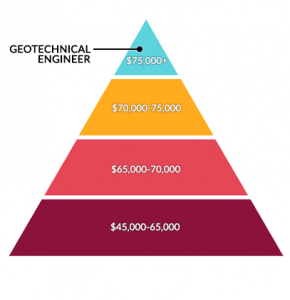Some Ideas on Geotheta You Need To Know
Wiki Article
Indicators on Geotheta You Need To Know
Table of ContentsThe Ultimate Guide To GeothetaThe Definitive Guide to GeothetaThe 4-Minute Rule for GeothetaThe Ultimate Guide To GeothetaGeotheta Things To Know Before You Buy

They perform site examinations, collect examples, perform lab examinations, and analyze data to review the viability of the ground for construction jobs - Consulting Engineers. Based on their findings, geotechnical engineers provide suggestions for foundation layout, incline security, retaining structures, and mitigation of geotechnical dangers. They team up with various other specialists, such as architects, architectural designers, and construction groups, to ensure that geotechnical considerations are integrated into the overall project layout and application
By evaluating the behavior and properties of soil and rock, they can identify potential geotechnical threats such as landslides, dirt negotiation, or incline instability. Their expertise aids prevent failings or crashes that can threaten lives and home. Right here are some in-depth tasks and obligations of a geotechnical engineer: Site Investigation: Geotechnical designers conduct site investigations to gather information on subsurface problems.
They analyze the information to recognize the properties and behavior of the dirt and rock, including their toughness, leaks in the structure, compaction characteristics, and groundwater conditions. Geotechnical Analysis and Design: Geotechnical designers evaluate the data gathered throughout site examinations to assess the stability and suitability of the website for building and construction jobs. They execute geotechnical calculations and modeling to examine elements such as bearing ability, negotiation, slope stability, side earth pressures, and groundwater circulation.
The 7-Minute Rule for Geotheta
Structure Style: Geotechnical engineers play a critical duty in creating foundations that can safely sustain the desired structure. They assess the soil conditions and tons needs to figure out the suitable foundation kind, such as superficial foundations (e.g., footings), deep structures (e.g (https://allmyfaves.com/geotheta?tab=Geotheta)., heaps), or specialized methods like soil improvement. They take into consideration aspects such as settlement limitations, bearing capacity, and soil-structure communication to create optimum structure stylesThey assess construction plans, screen website tasks, and carry out field assessments to verify that the layout recommendations are adhered to. If unpredicted geotechnical issues arise, they examine the circumstance and supply recommendations for remediation or modifications to the layout. Risk Evaluation and Mitigation: Geotechnical designers analyze geotechnical hazards and risks connected with the job site, such as landslides, liquefaction, or dirt erosion.

Cooperation and Communication: Geotechnical engineers work closely with other professionals associated with a job, such as designers, structural designers, and building and construction teams. Effective interaction and collaboration are important to integrate geotechnical factors to consider into the general job design and construction procedure. Geotechnical engineers supply technical proficiency, solution inquiries, and make certain that geotechnical demands are fulfilled.
Geotheta for Beginners
Below are some kinds of geotechnical designers: Foundation Engineer: Foundation engineers concentrate on designing and evaluating foundations for structures. They analyze the dirt problems, load demands, and site qualities to figure out one of the most appropriate foundation type and design, such as shallow foundations, deep foundations, or specialized techniques like stack foundations.They assess the elements influencing incline security, such as dirt homes, groundwater conditions, and slope geometry, and develop techniques to stop incline failings and alleviate risks. Quake Engineer: Quake engineers specialize in evaluating and developing structures to stand up to seismic forces. They examine the seismic danger of a website, examine dirt liquefaction possibility, and establish seismic style criteria to guarantee the safety and security and resilience of frameworks throughout quakes.
They carry out field testing, accumulate examples, and evaluate the collected information to define the soil residential properties, geologic formations, and groundwater conditions at a website. Geotechnical Instrumentation Engineer: Geotechnical instrumentation engineers concentrate on tracking and measuring the behavior of dirt, rock, and structures. They install and keep instrumentation systems that keep an eye on variables such as dirt negotiation, groundwater levels, slope movements, and architectural displacements to assess efficiency and offer early cautions of potential concerns.
Geotheta Can Be Fun For Everyone
They carry out examinations such as triaxial tests, combination tests, straight shear examinations, and permeability examinations to collect data for geotechnical analysis and layout. Geosynthetics Engineer: Geosynthetics engineers concentrate on the design and application of geosynthetic materials, such as geotextiles, geogrids, and geomembranes. They utilize these materials to enhance soil stability, enhance slopes, supply water drainage services, and control disintegration.They often tend to be investigative individuals, which indicates they're intellectual, reflective, and inquisitive. They wonder, systematic, sensible, analytical, and logical. A few of them are additionally social, meaning they're kind, generous, cooperative, client, caring, handy, empathetic, skillful, and pleasant. Does this seem like you? Take our free profession examination to discover if geotechnical designer is one of your top profession matches.
In the office environment, geotechnical designers use specialized software application tools to perform estimations, develop styles, and evaluate data. They prepare records, testimonial job specs, communicate with customers and staff member, and coordinate job activities. The office setup supplies a favorable environment for research study, analysis, and collaboration with various other experts associated with from this source the task.
Getting The Geotheta To Work
They often see job websites to conduct website investigations, analyze geotechnical conditions, and collect information for analysis. These brows through involve taking a trip to different places, in some cases in remote or challenging surfaces. Geotechnical designers may execute soil tasting, conduct examinations, and monitor building and construction activities to make sure that the geotechnical facets of the job are being applied correctly.Geotechnical designers also work in specialized geotechnical laboratories. Geotechnical laboratory engineers work extensively in these environments, dealing with testing equipment, operating instruments, and tape-recording data.
Report this wiki page